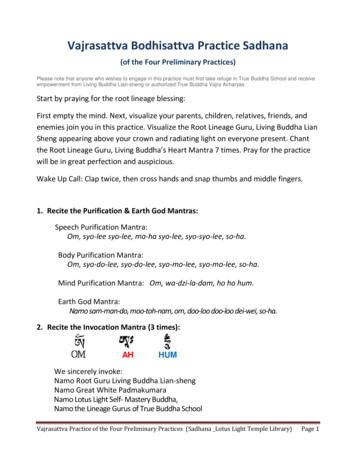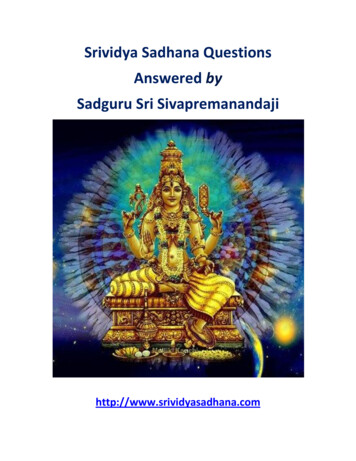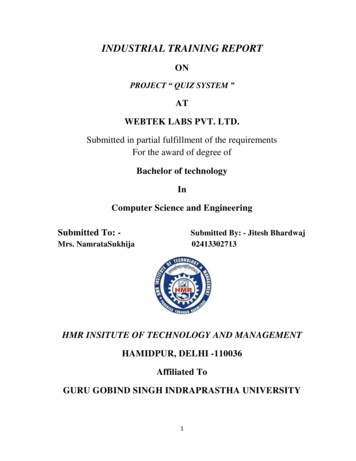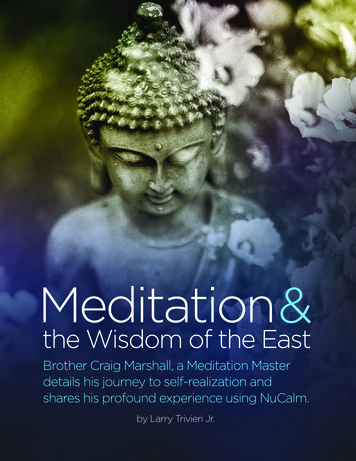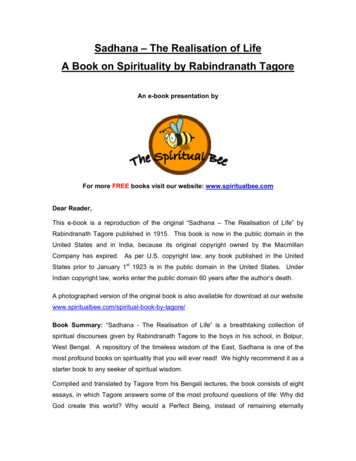
Transcription
Sadhana – The Realisation of LifeA Book on Spirituality by Rabindranath TagoreAn e-book presentation byFor more FREE books visit our website: www.spiritualbee.comDear Reader,This e-book is a reproduction of the original “Sadhana – The Realisation of Life” byRabindranath Tagore published in 1915. This book is now in the public domain in theUnited States and in India, because its original copyright owned by the MacmillanCompany has expired. As per U.S. copyright law, any book published in the UnitedStates prior to January 1st 1923 is in the public domain in the United States. UnderIndian copyright law, works enter the public domain 60 years after the author’s death.A photographed version of the original book is also available for download at our re/Book Summary: “Sadhana - The Realisation of Life” is a breathtaking collection ofspiritual discourses given by Rabindranath Tagore to the boys in his school, in Bolpur,West Bengal. A repository of the timeless wisdom of the East, Sadhana is one of themost profound books on spirituality that you will ever read! We highly recommend it as astarter book to any seeker of spiritual wisdom.Compiled and translated by Tagore from his Bengali lectures, the book consists of eightessays, in which Tagore answers some of the most profound questions of life: Why didGod create this world? Why would a Perfect Being, instead of remaining eternally
concentrated in Himself, go through the trouble of manifesting the Universe? Why doesevil exist? Do love and beauty have a purpose?Tagore masterfully brings the spiritual truths behind these profound questions to light,with his lucid explanations of the Sanskrit verses of the Upanishads1 and the eternalteachings of Lord Jesus and Buddha.Sadhana is one of those rare books that need to be read slowly, as each sentencecontains an immense amount of wisdom to be digested! In the end Tagore’s captivatingand rational explanations will leave you feeling breathless, exhilarated and brimmingwith peace, happiness and joy, as you become aware of the tremendous unifying forcebehind this immensely diverse and awe-inspiring Creation!We hope that you enjoy reading this masterpiece as much as we did!Sinceknowledge grows by sharing, do forward this e-book to your friends and family.Kind regards,The Spiritual BeeSadhana:The Realizationof oneLife -ofAnthee-bookpresentationTheofSpiritualBee civilization dating to 800 B.C.1.The Upanishadsareearliestspiritual bytextsthe Indian2
NoteTo enhance the readability of this book we have moved the Sanskrit verses from thefootnotes into the text and provided meanings for difficult words. Please note that thespellings of many of the words are in British English, prevalent in India during Tagore’stime.Terms of UseWe have tried our utmost to maintain the integrity of the original work. However during the transcribing process it ispossible that some errors may have crept in. By reading, downloading, altering or distributing this book you agree toindemnify us of all errors, liabilities, cost and legal expenses.
SĀDHANĀTHE REALISATION OF LIFEBYRABINDRANATH TAGOREAUTHOR OF ‘GITANJALI’NEW YORKTHE MACMILLIAN COMPANY1915Sadhana: The Realization of Life - An e-book presentation by The Spiritual Bee1
ToErnest RhysSadhana: The Realization of Life - An e-book presentation by The Spiritual Bee2
Author's PrefacePerhaps it is well for me to explain that the subject-matter of the papers published in thisbook has not been philosophically treated, nor has it been approached from the scholar'spoint of view. The writer has been brought up in a family where texts of the Upanishadsare used in daily worship; and he has had before him the example of his father, wholived his long life in the closest communion with God, while not neglecting his duties tothe world, or allowing his keen interest in all human affairs to suffer any abatement. Soin these papers, it may be hoped, western readers will have an opportunity of cominginto touch with the ancient spirit of India as revealed in our sacred texts and manifestedin the life of to-day.All the great utterances of man have to be judged not by the letter but by the spirit - thespirit which unfolds itself with the growth of life in history. We get to know the realmeaning of Christianity by observing its living aspect at the present moment - howeverdifferent that may be, even in important respects, from the Christianity of earlier periods.For western scholars the great religious scriptures of India seem to possess merely aretrospective and archaeological interest; but to us they are of living importance, and wecannot help thinking that they lose their significance when exhibited in labeled cases mummied specimens of human thought and aspiration, preserved for all time in thewrappings of erudition.The meaning of the living words that come out of the experiences of great hearts cannever be exhausted by any one system of logical interpretation.They have to beendlessly explained by the commentaries of individual lives, and they gain an addedmystery in each new revelation. To me the verses of the Upanishads and the teachingsof Buddha have ever been things of the spirit, and therefore endowed with boundlessvital growth; and I have used them, both in my own life and in my preaching, as beinginstinct with individual meaning for me, as for others, and awaiting for their confirmation,my own special testimony, which must have its value because of its individuality.I should add perhaps that these papers embody in a connected form, suited to thispublication, ideas which have been culled from several of the Bengali discourses which Iam in the habit of giving to my students in my school at Bolpur in Bengal; and I haveSadhana: The Realization of Life - An e-book presentation by The Spiritual Bee3
used here and there translations of passages from these done by my friends, BabuSatish Chandra Roy and Babu Ajit Kumar Chakravarti. The last paper of this series,"Realisation in Action," has been translated from my Bengali discourse on "Karmayoga" by my nephew, Babu Surendra Nath Tagore.I take this opportunity of expressing my gratitude to Professor James H. Woods, ofHarvard University, for his generous appreciation which encouraged me to complete thisseries of papers and read most of them before the Harvard University. And I offer mythanks to Mr. Ernest Rhys for his kindness in helping me with suggestions and revisions,and in going through the proofs.A word may be added about the pronouncing of Sādhanā: the accent falls decisively onthe first ā, which has the broad sound of the letter.RABINDRANATH TAGORESadhana: The Realization of Life - An e-book presentation by The Spiritual Bee4
CONTENTSI. THE RELATION OF THE INDIVIDUAL TO THE UNIVERSE .6II. SOUL CONSCIOUSNESS .18III. THE PROBLEM OF EVIL .30IV. THE PROBLEM OF SELF 40V. REALISATION IN LOVE .53VI. REALISATION IN ACTION .66VII. THE REALISATION OF BEAUTY .76VIII. THE REALISATION OF THE INFINITE .81Sadhana: The Realization of Life - An e-book presentation by The Spiritual Bee5
ITHE RELATION OF THE INDIVIDUAL TO THEUNIVERSEThe civilisation of ancient Greece was nurtured within city walls. In fact, all the moderncivilisations have their cradles of brick and mortar.These walls leave their mark deep in the minds of men. They set up a principle of"divide and rule" in our mental outlook, which begets in us a habit of securing all ourconquests by fortifying them and separating them from one another. We divide nationand nation, knowledge and knowledge, man and nature.It breeds in us a strongsuspicion of whatever is beyond the barriers we have built, and everything has to fighthard for its entrance into our recognition.When the first Aryan invaders appeared in India it was a vast land of forests, and thenew-comers rapidly took advantage of them. These forests afforded them shelter fromthe fierce heat of the sun and the ravages of tropical storms, pastures for cattle, fuel forsacrificial fire, and materials for building cottages. And the different Aryan clans withtheir patriarchal heads settled in the different forest tracts which had some specialadvantage of natural protection, and food and water in plenty.Thus in India it was in the forests that our civilisation had its birth, and it took a distinctcharacter from this origin and environment. It was surrounded by the vast life of nature,was fed and clothed by her, and had the closest and most constant intercourse with hervarying aspects.Such a life, it may be thought, tends to have the effect of dulling human intelligence anddwarfing the incentives to progress by lowering the standards of existence.But inancient India we find that the circumstances of forest life did not overcome man's mind,and did not enfeeble the current of his energies, but only gave to it a particular direction.Having been in constant contact with the living growth of nature, his mind was free fromthe desire to extend his dominion by erecting boundary walls around his acquisitions.His aim was not to acquire but to realise, to enlarge his consciousness by growing withSadhana: The Realization of Life - An e-book presentation by The Spiritual Bee6
and growing into his surroundings. He felt that truth is all-comprehensive, that there isno such thing as absolute isolation in existence, and the only way of attaining truth isthrough the interpenetration of our being into all objects. To realise this great harmonybetween man's spirit and the spirit of the world was the endeavour of the forest-dwellingsages of ancient India.In later days there came a time when these primeval forests gave way to cultivatedfields, and wealthy cities sprang up on all sides. Mighty kingdoms were established,which had communications with all the great powers of the world. But even in theheyday of its material prosperity the heart of India ever looked back with adoration uponthe early ideal of strenuous self-realisation, and the dignity of the simple life of the foresthermitage, and drew its best inspiration from the wisdom stored there.The west seems to take a pride in thinking that it is subduing nature; as if we are living ina hostile world where we have to wrest everything we want from an unwilling and alienarrangement of things. This sentiment is the product of the city-wall habit and training ofmind. For in the city life man naturally directs the concentrated light of his mental visionupon his own life and works, and this creates an artificial dissociation between himselfand the Universal Nature within whose bosom he lies.But in India the point of view was different; it included the world with the man as onegreat truth. India put all her emphasis on the harmony that exists between the individualand the universal.She felt we could have no communication whatever with oursurroundings if they were absolutely foreign to us. Man's complaint against nature is thathe has to acquire most of his necessaries by his own efforts. Yes, but his efforts are notin vain; he is reaping success every day, and that shows there is a rational connectionbetween him and nature, for we never can make anything our own except that which istruly related to us.We can look upon a road from two different points of view. One regards it as dividing usfrom the object of our desire; in that case we count every step of our journey over it assomething attained by force in the face of obstruction. The other sees it as the roadwhich leads us to our destination; and as such it is part of our goal. It is already thebeginning of our attainment, and by journeying over it we can only gain that which initself it offers to us. This last point of view is that of India with regard to nature. For her,Sadhana: The Realization of Life - An e-book presentation by The Spiritual Bee7
the great fact is that we are in harmony with nature; that man can think because histhoughts are in harmony with things; that he can use the forces of nature for his ownpurpose only because his power is in harmony with the power which is universal, andthat in the long run his purpose never can knock against the purpose which worksthrough nature.In the west the prevalent feeling is that nature belongs exclusively to inanimate thingsand to beasts, that there is a sudden unaccountable break where human-nature begins.According to it, everything that is low in the scale of beings is merely nature, andwhatever has the stamp of perfection on it, intellectual or moral, is human-nature. It islike dividing the bud and the blossom into two separate categories, and putting theirgrace to the credit of two different and antithetical principles. But the Indian mind neverhas any hesitation in acknowledging its kinship with nature, its unbroken relation with all.The fundamental unity of creation was not simply a philosophical speculation for India; itwas her life-object to realise this great harmony in feeling and in action. With mediationand service, with a regulation of life, she cultivated her consciousness in such a way thateverything had a spiritual meaning to her. The earth, water and light, fruits and flowers,to her were not merely physical phenomena to be turned to use and then left aside.They were necessary to her in the attainment of her ideal of perfection, as every note isnecessary to the completeness of the symphony. India intuitively felt that the essentialfact of this world has a vital meaning for us; we have to be fully alive to it and establish aconscious relation with it, not merely impelled by scientific curiosity or greed of materialadvantage, but realising it in the spirit of sympathy, with a large feeling of joy and peace.The man of science knows, in one aspect, that the world is not merely what it appears tobe to our senses; he knows that earth and water are really the play of forces thatmanifest themselves to us as earth and water - how, we can but partially apprehend.Likewise the man who has his spiritual eyes open knows that the ultimate truth aboutearth and water lies in our apprehension of the eternal will which works in time and takesshape in the forces we realise under those aspects. This is not mere knowledge, asscience is, but it is a preception of the soul by the soul. This does not lead us to power,as knowledge does, but it gives us joy, which is the product of the union of kindredthings. The man, whose acquaintance with the world does not lead him deeper thanscience leads him, will never understand what it is that the man with the spiritual visionSadhana: The Realization of Life - An e-book presentation by The Spiritual Bee8
finds in these natural phenomena. The water does not merely cleanse his limbs, but itpurifies his heart; for it touches his soul. The earth does not merely hold his body, but itgladdens his mind; for its contact is more than a physical contact - it is a living presence.When a man does not realise his kinship with the world, he lives in a prison-housewhose walls are alien to him. When he meets the eternal spirit in all objects, then is heemancipated, for then he discovers the fullest significance of the world into which he isborn; then he finds himself in perfect truth, and his harmony with the all is established.In India men are enjoined to be fully awake to the fact that they are in the closest relationto things around them, body and soul, and that they are to hail the morning sun, theflowing water, the fruitful earth, as the manifestation of the same living truth which holdsthem in its embrace. Thus the text of our everyday meditation is the Gayatri, a versewhich is considered to be the epitome of all the Vedas. By its help we try to realise theessential unity of the world with the conscious soul of man; we learn to perceive the unityheld together by the one Eternal Spirit, whose power creates the earth, the sky, and thestars, and at the same time irradiates our minds with the light of a consciousness thatmoves and exists in unbroken continuity with the outer world.It is not true that India has tried to ignore differences of value in different things, for sheknows that would make life impossible. The sense of the superiority of man in the scaleof creation has not been absent from her mind. But she has had her own idea as to thatin which his superiority really consists. It is not in the power of possession but in thepower of union. Therefore India chose her places of pilgrimage wherever there was innature some special grandeur or beauty, so that her mind could come out of its world ofnarrow necessities and realise its place in the infinite. This was the reason why in Indiaa whole people who once were meat-eaters gave up taking animal food to cultivate thesentiment of universal sympathy for life, an event unique in the history of mankind.India knew that when by physical and mental barriers we violently detach ourselves fromthe inexhaustible life of nature; when we become merely man, but not man-in-theuniverse, we create bewildering problems, and having shut off the source of theirsolution, we try all kinds of artificial methods each of which brings its own crop ofinterminable difficulties. When man leaves his resting-place in universal nature, whenhe walks on the single rope of humanity, it means either a dance or a fall for him, he hasceaselessly to strain every nerve and muscle to keep his balance at each step, and then,Sadhana: The Realization of Life - An e-book presentation by The Spiritual Bee9
in the intervals of his weariness, he fulminates against Providence and feels a secretpride and satisfaction in thinking that he has been unfairly dealt with by the wholescheme of things.But this cannot go on for ever. Man must realise the wholeness of his existence, hisplace in the infinite; he must know that hard as he may strive he can never create hishoney within the cells of his hive; for the perennial supply of his life food is outside theirwalls. He must know that when man shuts himself out from the vitalising and purifyingtouch of the infinite, and falls back upon himself for his sustenance and his healing, thenhe goads himself into madness, tears himself into shreds, and eats his own substance.Deprived of the background of the whole, his poverty loses its one great quality, which issimplicity, and becomes squalid and shamefaced.His wealth is no longermagnanimous; it grows merely extravagant. His appetites do not minister to his life,keeping to the limits of their purpose; they become an end in themselves and set fire tohis life and play the fiddle in the lurid light of the conflagration. Then it is that in our selfexpression we try to startle and not to attract; in art we strive for originality and lose sightof truth which is old and yet ever new; in literature we miss the complete view of manwhich is simple and yet great, but he appears as a psychological problem or theembodiment of a passion that is intense because abnormal and because exhibited in theglare of a fiercely emphatic light which is artificial.When man's consciousness isrestricted only to the immediate vicinity of his human self, the deeper roots of his naturedo not find their permanent soil, his spirit is ever on the brink of starvation, and in theplace of healthful strength he substitutes rounds of stimulation. Then it is that manmisses his inner perspective and measures his greatness by its bulk and not by its vitallink with the infinite, judges his activity by its movement and not by the repose ofperfection - the repose which is in the starry heavens, in the ever-flowing rhythmic danceof creation.The first invasion of India has its exact parallel in the invasion of America by theEuropean settlers. They also were confronted with primeval forests and a fierce strugglewith aboriginal races. But this struggle between man and man, and man and naturelasted till the very end; they never came to any terms. In India the forests which werethe habitation of the barbarians became the sanctuary of sages, but in America thesegreat living cathedrals of nature had no deeper significance to man.They broughtwealth and power to him, and perhaps at times they ministered to his enjoyment ofSadhana: The Realization of Life - An e-book presentation by The Spiritual Bee10
beauty, and inspired a solitary poet. They never acquired a sacred association in thehearts of men as the site of some great spiritual reconcilement where man's soul has itsmeeting-place with the soul of the world.I do not for a moment wish to suggest that these things should have been otherwise. Itwould be an utter waste of opportunities if history were to repeat itself exactly in thesame manner in every place.It is best for the commerce of the spirit that peopledifferently situated should bring their different products into the market of humanity, eachof which is complementary and necessary to the others. All that I wish to say is thatIndia at the outset of her career met with a special combination of circumstances whichwas not lost upon her. She had, according to her opportunities, thought and pondered,striven and suffered, dived into the depths of existence, and achieved something whichsurely cannot be without its value to people whose evolution in history took a differentway altogether. Man for his perfect growth requires all the living elements that constitutehis complex life; that is why his food has to be cultivated in different fields and broughtfrom different sources.Civilisation is a kind of mould that each nation is busy making for itself to shape its menand women according to its best ideal. All its institutions, its legislature, its standard ofapprobation and condemnation, its conscious and unconscious teachings tend towardthat object. The modern civilisation of the west, by all its organised efforts, is trying toturn out men perfect in physical, intellectual, and moral efficiency.There the vastenergies of the nations are employed in extending man's power over his surroundings,and people are combining and straining every faculty to possess and to turn to accountall that they can lay their hands upon, to overcome every obstacle on their path ofconquest. They are ever disciplining themselves to fight nature and other races; theirarmaments are getting more and more stupendous every day; their machines, theirappliances, their organisations go on multiplying at an amazing rate. This is a splendidachievement, no doubt, and a wonderful manifestation of man's masterfulness whichknows no obstacle, and which has for its object the supremacy of himself overeverything else.The ancient civilisation of India had its own ideal of perfection towards which its effortswere directed. Its aim was not attaining power, and it neglected to cultivate to theutmost its capacities, and to organise men for defensive and offensive purposes, for co-Sadhana: The Realization of Life - An e-book presentation by The Spiritual Bee11
operation in the acquisition of wealth and for military and political ascendancy. The idealthat India tried to realise led her best men to the isolation of a contemplative life, and thetreasures that she gained for mankind by penetrating into the mysteries of reality costher dear in the sphere of worldly success. Yet, this also was a sublime achievement, - itwas a supreme manifestation of that human aspiration which knows no limit, and whichhas for its object nothing less than the realisation of the Infinite.There were the virtuous, the wise, the courageous; there were the statesmen, kings andemperors of India; but whom amongst all these classes did she look up to and choose tobe the representative of men?They were the rishis. What were the rishis?Samprāpyainam rishayo jñānatripatāhKritātmānō vītarāgāh praçantāhtē sarvagam sarvatah prāpya dhīrāhYuktātmānah sarvamēvāviçantiThey who having attained the supreme soul in knowledge were filled with wisdom, andhaving found him in union with the soul were in perfect harmony with the inner self; theyhaving realised him in the heart were free from all selfish desires, and havingexperienced him in all the activities of the world, had attained calmness. The rishis werethey who having reached the supreme God from all sides had found abiding peace, hadbecome united with all, had entered into the life of the Universe.Thus the state of realising our relationship with all, of entering into everything throughunion with God, was considered in India to be the ultimate end and fulfilment ofhumanity.Man can destroy and plunder, earn and accumulate, invent and discover, but he is greatbecause his soul comprehends all. It is dire destruction for him when he envelopes hissoul in a dead shell of callous habits, and when a blind fury of works whirls round himlike an eddying dust storm, shutting out the horizon. That indeed kills the very spirit of hisbeing, which is the spirit of comprehension. Essentially man is not a slave either ofhimself or of the world; but he is a lover. His freedom and fulfilment is in love, which isanother name for perfect comprehension.By this power of comprehension, thispermeation of his being, he is united with the all-pervading Spirit, who is also the breathSadhana: The Realization of Life - An e-book presentation by The Spiritual Bee12
of his soul. Where a man tries to raise himself to eminence by pushing and jostling allothers, to achieve a distinction by which he prides himself to be more than everybodyelse, there he is alienated from that Spirit. This is why the Upanishads describe thosewho have attained the goal of human life as "peaceful" (Praçantāh) and as "at-one-withGod," (Yuktātmānah) meaning that they are in perfect harmony with man and nature,and therefore in undisturbed union with God.We have a glimpse of the same truth in the teachings of Jesus when he says, "It iseasier for a camel to pass through the eye of a needle than for a rich man to enter thekingdom of Heaven" - which implies that whatever we treasure for ourselves separatesus from others; our possessions are our limitations. He who is bent upon accumulatingriches is unable, with his ego continually bulging, to pass through the gates ofcomprehension of the spiritual world, which is the world of perfect harmony; he is shutup within the narrow walls of his limited acquisitions.Hence the spirit of the teachings of Upanishad is: In order to find him you must embraceall. In the pursuit of wealth you really give up everything to gain a few things, and that isnot the way to attain him who is completeness.Some modern philosophers of Europe, who are directly or indirectly indebted to theUpanishads, far from realising their debt, maintain that the Brahma of India is a mereabstraction, a negation of all that is in the world. In a word, that the Infinite Being is to befound nowhere except in metaphysics. It may be, that such a doctrine has been and stillis prevalent with a section of our countrymen. But this is certainly not in accord with thepervading spirit of the Indian mind. Instead, it is the practice of realising and affirmingthe presence of the infinite in all things which has been its constant inspiration.Içāvāsyamidam sarvam yat kiñcha jagatyāñ jagatWe are enjoined to see whatever there is in the world as being enveloped by God.Yo dēvō'gnau y'ōpsu y'ō viçvambhuvanamāvivēça ya ōshadhishu yōvanaspatishu tasmai dēvāya namōnamahI bow to God over and over again who is in fire and in water, who permeates the wholeworld, who is in the annual crops as well as in the perennial trees.Sadhana: The Realization of Life - An e-book presentation by The Spiritual Bee13
Can this be God abstracted from the world? Instead, it signifies not merely seeing him inall things, but saluting him in all the objects of the world. The attitude of the Godconscious man of the Upanishad towards the universe is one of a deep feeling ofadoration. His object of worship is present everywhere. It is the one living truth thatmakes all realities true.This truth is not only of knowledge but of devotion.'Namonamah' - we bow to him everywhere, and over and over again. It is recognised inthe outburst of the Rishi, who addresses the whole world in a sudden ecstasy of joy:Çrinvantu viçve amritasya putrā ā ye divya dhāmāni tasthuh vedāhametampurusham mahāntam āditya varņam tamasah parastātListen to me, ye sons of the immortal spirit, ye who live in the heavenly abode, I haveknown the Supreme Person whose light shines forth from beyond the darkness.Do we not find the overwhelming delight of a direct and positive experience where thereis not the least trace of vagueness or passivity?Buddha who developed the practical side of the teaching of Upanishads, preached thesame message when he said, “With everything, whether it is above or below, remote ornear, visible or invisible, thou shalt preserve a relation of unlimited love without anyanimosity or without a desire to kill. To live in such a consciousness while standing orwalking, sitting or lying down till you are asleep, is Brahma vihāra, or, in other words, isliving and moving and having your joy in the spirit of Brahma.”What is that spirit? The Upanishad says,Yaçchāyamasminnākāçē tējōmayō'mritamayah purushah sarvānubhūhThe being who is in his essence the light and life of all, who is world-conscious, isBrahma. To feel all, to be conscious of everything, is his spirit. We are immersed in hisconsciousness body and soul. It is through his consciousness that the sun attracts theearth; it is through his consciousness that the light-waves are being transmitted fromplanet to planet.Yaçchāyamasminnātmani tējōmayō'mritamayah purushah sarvānubhūhSadhana: The Realization of Life - An e-book presentation by The Spiritual Bee14
Not only in space, but this light and life, this all-feeling being is in our souls. He is allconscious in space, or
Tagore masterfully brings the spiritual truths behind these profound questions to light, with his lucid explanations of the Sanskrit verses of the Upanishads1 and the eternal teachings of Lord Jesus and Buddha. Sadhana is one of those rare books that need to be read slowly, as each sentence contains an immense amount of wisdom to be digested!



